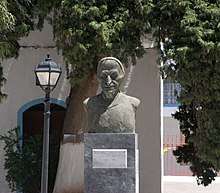Lady of Ro
Despina Achladioti (Greek: Δέσποινα Αχλαδιώτη), known as the Lady of Ro (Κυρά της Ρω), was a Greek patriot born on the island of Kastellórizo in 1890.
Despina Achladioti | |
|---|---|
 Monument of Despina Achladioti on Kastellorizo | |
| Born | 1890 Meis, Vilayet of the islands, Ottoman Empire |
| Died | May 13, 1982 (aged 92) |
| Resting place | Ro, Dodecanese, Greece |
| Nationality | Greek |
| Known for | Flying the Greek Flag on the Island of Ro and living there as a hermit |
Notable work | Member of the Greek Resistance during World War II |
Biography
In 1927, Achladioti sailed with her husband, Kostas Achladiotis (Greek: Κώστας Αχλαδιώτης), to the nearby deserted island of Ro where they lived off of a few goats, chickens, and a vegetable garden. In 1940, her husband got sick, Achladioti started three fires in order to inform the residents of Kastelorizo that they needed help, but her husband died on a boat which came to help. Achladioti then brought her blind mother to the islet, while later she personally rowed her mother's remains back to Kastellórizo for burial.[1] She has been compared to Joan d'Arc and Boudica.[1]
Achladioti's most renowned deed is that every day she would fly a Greek flag over the island, even though the island was not formally part of Greece (as with the rest of the Dodecanese controlled by Italy) until 1948. During World War II, she helped the members of Sacred Band against the Axis powers.
She raised the flag every day, regardless of the weather, from the time she arrived on the island until her death on May 13, 1982 at the age of 92.[2] Despite not having veteran status, she was buried on the island with full military honours.
A Greek military unit is now based on the island, with the main duty of keeping the tradition of raising the flag.[1]
.jpg)
References
- "Ekathimerini on Lady of Ro". Archived from the original on November 20, 2008. Retrieved 2009-08-09.CS1 maint: BOT: original-url status unknown (link) Article: The Lady of Ro’s memory lives on Kastellorizians revere symbol of Greek defiance, scoff at concerns of a flood of Turkish migrants By Brian Williams - Reuters
- Chroniko tou Eikostou Aiona (Chronicle of the 20th century), ed. 4E, Athens, 1990, p. 1258.
External links
